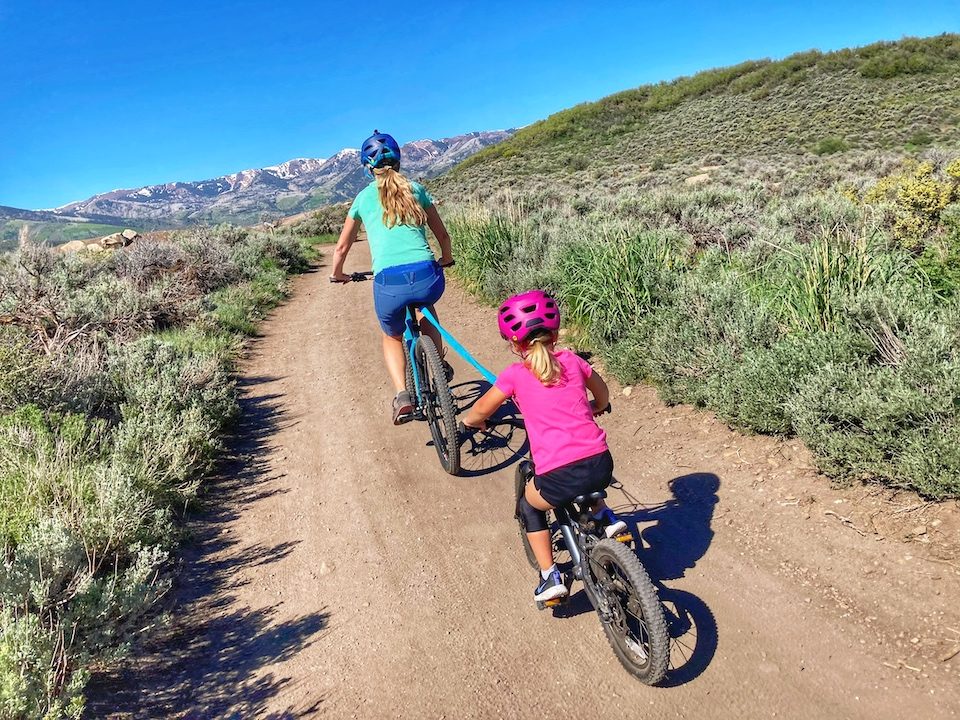So you’ve got yourself a tiny shredder and they need a 16 inch mountain bike. Riding basic dirt trails and single track as a 3, 4, or 5 year old requires less technical skill than the aggressive riding an older child might do. But there are still a few important features a boys or girls 16 inch mountain bike should have to set your ripper up for success.
A low, wide handlebar, a longer wheelbase, dual handbrakes, and knobby, wide tires are a few things we looked for when narrowing down our recommendations. Suspension fork? Not on our list of necessities. Coaster brake? Definitely NOT.
So what’s the best 16 inch kids mountain bike? Among other things, it depends on your child’s developmental stage, height, weight, and where they will be riding. Check out our six favorite bikes to determine which little pony is best for your grom. And for a discussion of what features really matter, (and which ones don’t!), you can drop down to our How to Choose section.

Best 16 Inch Kids Mountain Bikes
| Bike | Why We Love It | MSRP |
|---|---|---|
| Prevelo Zulu Two | Modern MTB Geometry, Wide Beefy Tires | $589 |
| Commencal Ramones 16 | Honorable Mention | $350 |
| Early Rider Seeker 16 | Incredibly lightweight, belt drive | $559 |
| Btwin HYC 500 Hybrid | Budget Option for Less Aggressive Riders | $125 |
THE BEST 16 INCH MOUNTAIN BIKES
Prevelo Zulu Two
Modern MTB geometry, beefy tires, hydraulic disc brakes
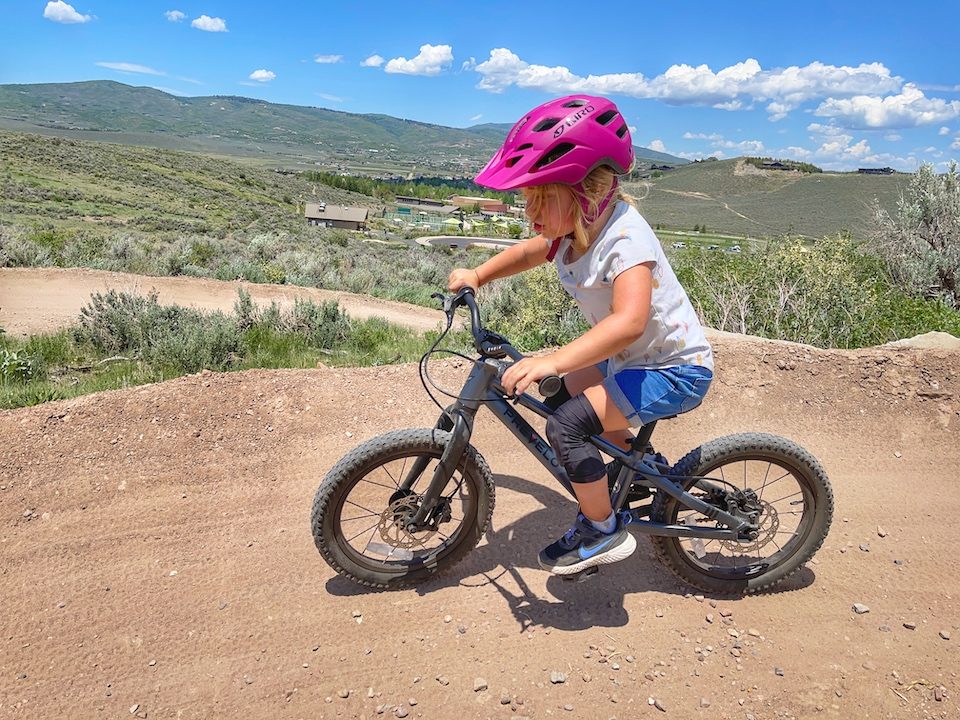
- MSRP: $589
- WEIGHT: 17.1 lbs, 17.9 with suspension fork
- SEAT HEIGHT: 18″ – 25″
- TIRES: Innova 16 x 2.1, can upgrade to ~2.25
- HANDLEBARS: 520 mm wide, 35 mm rise
- STANDOUT FEATURES: Modern MTB geometry, wide handlebars, hydraulic front and rear disc brakes, internally routed brake cable, optional air fork
- COMPLETE REVIEW: Prevelo Zulu Two
The Prevelo Zulu Two is a dream bike for MTB parents who want a rig for their kid that’s as cool as their own. With a long wheelbase, slack head tube, and steeper seat tube, the Zulu Two mimics the modern geometry of high-end adult bikes.
While the hydraulic disc brakes aren’t necessary at this age, we appreciate the high-end touch. This 16 inch mountain bike is also the only one on the list that has an optional air fork. We didn’t use suspension with our tester but know it’s an option if you want a truly tricked out bike.
Prevelo Alpha Two
A Lighter-weight Compact Trail Option (only 2022 models and older)
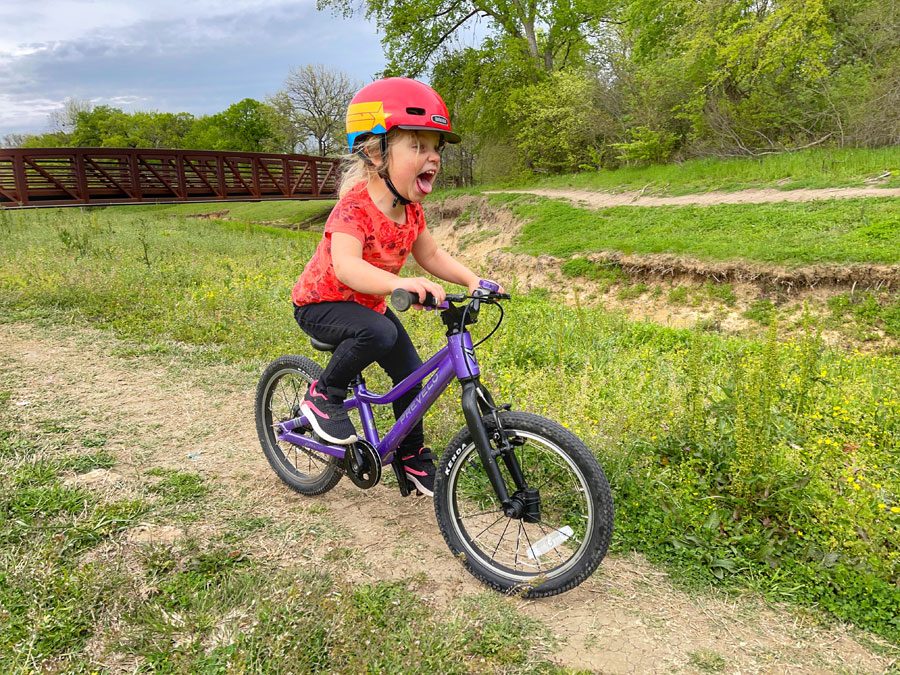
- MSRP: Used prices vary. We only recommend using 2022 and older models as a beginner mountain bike.
- WEIGHT: 14.9 lbs.
- SEAT HEIGHT: 17″ – 25″
- TIRES: Kenda Small Block Eight Pro 16 × 1.5, can upgrade up to ~2.25, but will need longer brake calipers at that width
- HANDLEBARS: 470 mm wide, 50 mm rise
- STANDOUT FEATURES: Smooth rolling Kenda tires, high-quality Tektro V-brakes, lightweight aluminum frame
- COMPLETE REVIEW: Prevelo Alpha Two
NOTE: This applies to models 2022 and older only. The 2023 model has significantly different geometry which makes it less suited for trail riding.
The Prevelo Alpha Two is designed as an aggressive 16 inch multi-use bike, making it more versatile than other bikes on this list. While it’s equally incredibly around the neighborhood, a developing shredder can certainly ride it on beginning trails. And at just under 15 pounds, it’s one of the lightest bikes on this list!
Our own little ripper has dominated everywhere from the skatepark, the Velosolutions pumptrack, and Bentonville’s flow trails with this little pony. While its tires are certainly knobby enough for great traction on packed dirt, they are more narrow than others. This makes the Alpha a great option for pretty much everything except loose dirt and rocky obstacles.
Cleary Hedgehog
Durable Steel Frame, Changeable Gain Ratio
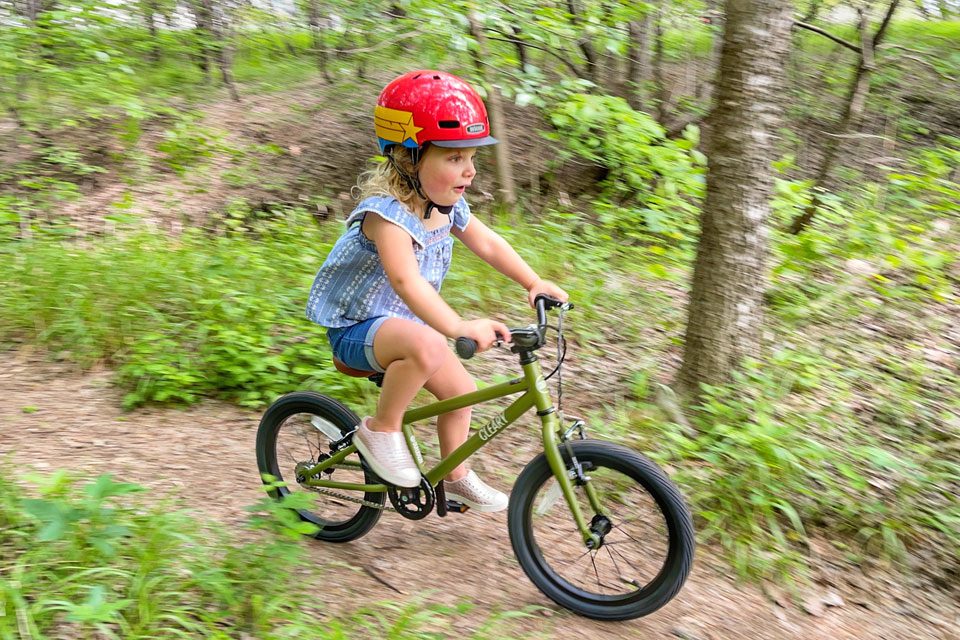
- MSRP: $265
- WEIGHT: 16 – 17 lbs, depending on tires
- SEAT HEIGHT: 17.5″ – 24.5″ (shorter seat post requires extra purchase)
- TIRES: 16 x 1.75 street tread
- HANDLEBARS: 500 mm wide, 50 mm rise
- STANDOUT FEATURES: Shock-absorbing steel frame, dual Tektro V-brakes, vegan leather saddle, several optional rear cogs available to change gain ratio
- COMPLETE REVIEW: Cleary Hedgehog
Cleary Bikes’ steel frames are built to last the beating kids give their bikes. That steel frame also has the added benefit of absorbing the chatter of the trail for a smoother ride.
While Cleary’s stock tires will do just fine on packed dirt, we recommend upgrading to a knobbier, beefier tire if you’ll be heading out to the single track on the regular.
The Cleary Hedgehog is unique because it’s the only bike on this list to offer several different rear cog options to customize the bike’s gain ratio to the terrain you’ll be riding most often.
Commencal Ramones 16
Honorable Mention
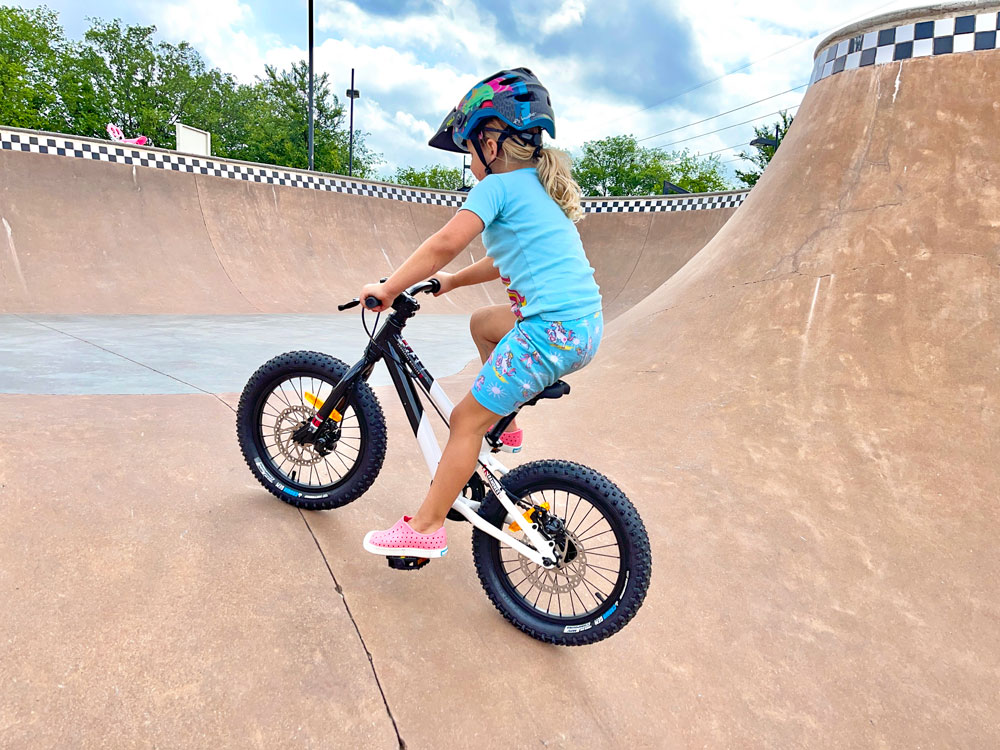
- MSRP: $350
- WEIGHT: 18.5 lbs
- SEAT HEIGHT: 20.8″ – 24.25″
- TIRES: Vee Tire Crown Gem 16 x 2.25
- STANDOUT FEATURES: Mechanical disc brakes, soft and kid-sized saddle
- COMPLETE REVIEW: Commencal Ramones 16
With wide, grippy tires, wide handlebars, and mechanical disc brakes, the Commencal Ramones 16 offers traction, maneuverability, and stopping power to quickly build skills and confidence. The Ramones is most similar to the Prevelo Zulu Two, but if you’re looking to save money with the Ramones, you need to be aware of differences in sizing.
The Ramones 16 has the tallest minimum seat height on this list – almost 3 inches taller than the Zulu Two. As a result, if your ripper is particularly young or small, they may need to grow before they fit on the Ramones. Additionally, the cockpit of the Ramones is a tad smaller than the Zulu’s, so your child’s body will be a bit cramped earlier on the Ramones than on the Zulu.
Overall, the Ramones is an exceptional and versatile little rig. Our test riders confidently tackled root-strewn trails and zoomed up and down steep skatepark ramps, but its room for growth is limited.
(Note: It is possible to lower the minimum seat height with a shorter seat post, or by cutting the included seat post. Based on the angle of the knee bend at the high stroke, we wouldn’t recommend lowering it much more than to 20″.)
Early Rider Seeker
Impressively Lightweight, Belt Drive

- MSRP: $559
- WEIGHT: ~14 lbs
- SEAT HEIGHT: 18.7″ – ?
- TIRES: Vee Crown Gem 16 x 2.25
- HANDLEBARS: 480 mm wide, 18 mm rise
- STANDOUT FEATURES: Weight-saving components like hollow axles; greaseless belt drive (also easy on the maintenance!), Tektro V-brakes, brushed aluminum finish hides scratches better than most
- COMPLETE REVIEW: Early Rider (Belter) 16
The lightest 16 inch mountain bike on the market, the Early Rider Seeker is exceptionally suited for those uphill climbs. And with Vee Crown 2.25″ wide tires, the Seeker’s ~14 pound weight is especially impressive.
As a single-speed bike, the Seeker’s belt drive only has upsides. Grease-free and essentially maintenance-free, the Seeker’s drivetrain is less likely to need time on the bike repair stand.
While we haven’t had the chance to put our little groms on this bike yet, its specs and geometry combined with its lightweight should put it near the top of your list.
Btwin HYC 500 Hybrid
Budget Option for Less Aggressive Riders
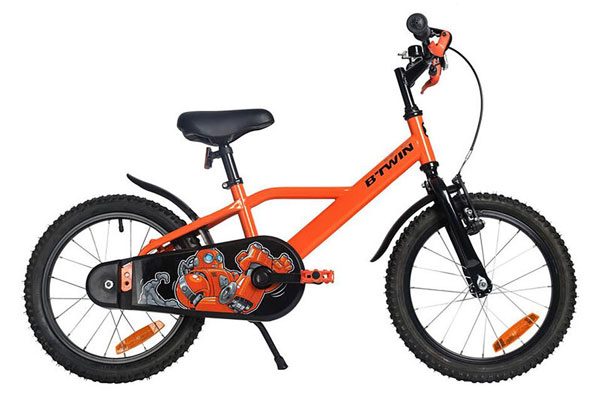
- MSRP: $125
- WEIGHT: 20.3 lbs.
- SEAT HEIGHT: 19.5″ – 23.75″
- STANDOUT FEATURES: Tektro V-brakes
- COMPLETE REVIEW: Btwin 16 Inch Bike (similar to Btwin HYC 500, but tires are different)
If spending over $200 on a 16 inch mountain bike makes your brain explode, consider the Btwin HYC 500 hybrid bike. The house brand for Decathlon sporting goods stores, Btwin kids bikes offer incredible value for young riders.
Overall kid-friendly geometry, knobby tires, and lightweight for the price, it doesn’t get better under $200. Of course there are drawbacks to spending under $200. 20 pounds is pretty heavy for a 3, 4, or 5 year old trying to learn the basics of technical riding. Also, there’s that pesky coaster brake.
We highly encourage you to at least upgrade to the Commencal, but if not, the Btwin is your best “truly cheap” option. We tested the version of this bike with street tires, but otherwise they are the same.
What to Look For When Choosing a 16 Inch
Mountain Bike
16 inch kids mountain bikes are different than 20 and 24 inch bikes. For one thing, you don’t have gears! Additionally, most 16 inch mountain bikes don’t have suspension. So with gears and suspension off the table, what’s important for your budding mountain biker’s first real rig?

Girls and Boys 16 inch Mountain Bikes
With kids mountain bikes, there are no gender-specific choices. All 16 kids mountain bikes are gender-neutral. If you’re looking for a “boys 16 inch mountain bike” or a “girls 16 inch mountain bike”, they don’t exist. Just find a bike with a color your kid loves, or swap out pedals and grips with more exciting colors or designs.
There are some differences in geometry in men’s and women’s mountain bikes to account for general differences in male and female anatomy, but this does not exist in the kids’ biking world.
Geometry
General kid-friendly geometry is fundamentally important for any child to have success on their bike – whether they are ripping up the trails or cruising the neighborhood.
Every bike on our list has bike geometry that is far superior to cheap bikes you will find at Walmart or on Amazon. That said, there are a few specs you should keep in mind for a child that will be riding their bike primarily as a mountain bike.
Low and Wide Handlebars: For a child to lean into turns and appropriately shift their weight on a bike, lower handlebars are ideal. While upright handlebars are more comfortable around the neighborhood, they will greatly limit your child’s ability to maneuver on the trail.
The best mountain bikes will also have slightly wider handlebars to improve stability and smoothness of steering.
Longer Wheelbase: A longer wheelbase (within reason!) means more stability on the bike. It also generally provides more room in the cockpit for a child to shift body position on the uphill, the downhill, and everything in between.
Head Angle and Seat Tube Angle: Modern adult mountain bikes have slacker head tube angles and steeper seat tube angles. While a 16 inch mountain bike with modern MTB geometry certainly isn’t a bad thing, its importance is pretty low given the beginning speed and skills a 3, 4, or 5 year old is going to have.
If the mountain bike you find for your little shredder has geometry similar to your own bike – awesome! But if its geometry is more in line with a high-end neighborhood bike, you’ll probably be just fine.
Wide, Knobby Tires

Besides having low and wide handlebars paired with a longer wheelbase, wider tires are going to be your little grom’s next best asset.
Beefy tires with appropriate tread provide better traction for dirt and rocks, and cushioning for rock gardens, baby jumps, and baby drops. They also allow you to lower the psi for even more traction and cushioning.
Tire width and tread is a pretty interesting subject, as there’s not one best tire for a 16 inch mountain bike. There are also very few 16 inch options even available. If you’re interested in how the pattern and size of the knobs affects a bike’s performance, check out this in-depth tread discussion by Liv Cycles.
Be sure to consider how a bike’s tires can be upgraded. For example, the Cleary Hedgehog comes standard with 1.75″ wide street tread tires, but can easily be transformed into a pretty legit mountain bike with Crown Gem 16 x 2.25″ wide tires.
Also keep in mind that wider, beefier tires are generally heavier, so don’t go too fat-tire crazy on your kid’s first mountain bike!
Weight
Besides all the other reasons to avoid a “mountain bike” from Walmart, a heavy bike can kill a kid’s riding experience. High-end 16 inch kids mountain bikes will weigh anywhere from just about 14 to 18 pounds.
Even within that lower weight range for high-end bikes, we’ve seen skilled riders struggle on inclines with a 17 pound bike, but ride similar inclines with ease on a 15 pound bike. When your kid only weighs 40 pounds, a 2 pound difference in bike weight will result in more drastic effects on their ability to ride.
Brakes
While it may seem obvious to avoid a “mountain bike” from Walmart, you should also avoid most 16 inch bikes sold at a bike shop. “But,” you say, “I bought a Trek or Specialized and it’s a killer bike!” Unfortunately, pretty much all 16 inch bikes at bike shops have coaster brakes. You do NOT want coaster brakes if your child is going to be learning to navigate true MTB trails and features.
So what are your best options?
V-Pull: The best brakes for a 3, 4, or 5 year old are a high-quality set of mini V-brakes. All of the bikes on our list will have brakes with solid stopping power, and will also have small levers with short reach made for little fingers.

Disc Brakes: But what about mechanical or hydraulic disc brakes? No legit adult mountain bike has V-brakes, so why should I settle for V-brakes on my kid’s bike?
While there are a few 16 inch kids mountain bikes available with mechanical or hydraulic disc brakes, in our opinion, they aren’t necessary. Kids this age just don’t weigh enough and aren’t going fast enough to need the extra stopping power of disc brakes.
Additionally, disc brakes can actually be too powerful for young kids who still mix up their left and right, and who certainly are not able to modulate their braking power on their own. A young child is more likely to endo on a bike with disc brakes than they are on a bike with V-brakes.
Suspension Fork
Honestly, you don’t need a suspension fork on a 16 inch bike. YOU may want one, but your kid doesn’t need one. (Feel free to argue with us about that in the comments below. Ha!)
These tiny riders on 16 inch mountain bikes just don’t weigh enough for the dampening of a fork to help much. And they probably won’t be regularly riding terrain where a front suspension fork would matter much – even for an adult.
But what if your child will be riding chunky terrain? You should also consider that rigid forks help a rider to feel the trail and learn how to ride technically. Giving a child a suspension fork too early could potentially delay their technical riding skills. Suspension forks also add weight to a bike.
If you are set on suspension, your best bet is the Prevelo Zulu Heir. Other very small brands like Little Shredder and Slater bikes offer custom options between $1000 – $3000.
Gears – Single Speed!
While adult mountain bikers live and die by their ability to shift quickly, 16 inch mountain bikes are only single speed. Kids this age just don’t have the developmental ability to worry about shifting gears.
But what gear that single speed is in will make a huge difference in your child’s riding experience. The bikes on our list range from 3.1 gain ratio to 3.8. That’s quite a range.
Lower gain ratios will be useful for kids who will be powering up inclines without the aid of a tow rope. Slightly higher gain ratios will be better for covering flatter terrain or downhill. Which gain ratio is best for your child is completely dependent on where you will be riding most of the time.
If you think you may want to change the gain ratio over time (as your child gets stronger, or moves on to a different style of riding), you may want to consider the Cleary Hedgehog which has optional rear cogs to make changing the gain ratio easy.
There is one 16″ mountain bike with gears – the Mondraker Leader 16. But it’s a lot of money for a feature your kid probably won’t use much, or use correctly.
No matter what gain ratio you choose, BUY A TOW ROPE! It has been a staple in our family bike life – we couldn’t live without it on those extended inclines!
